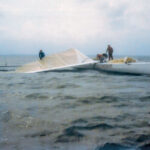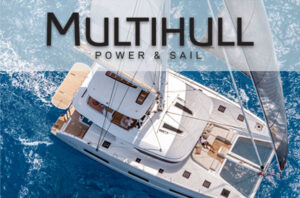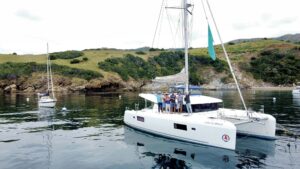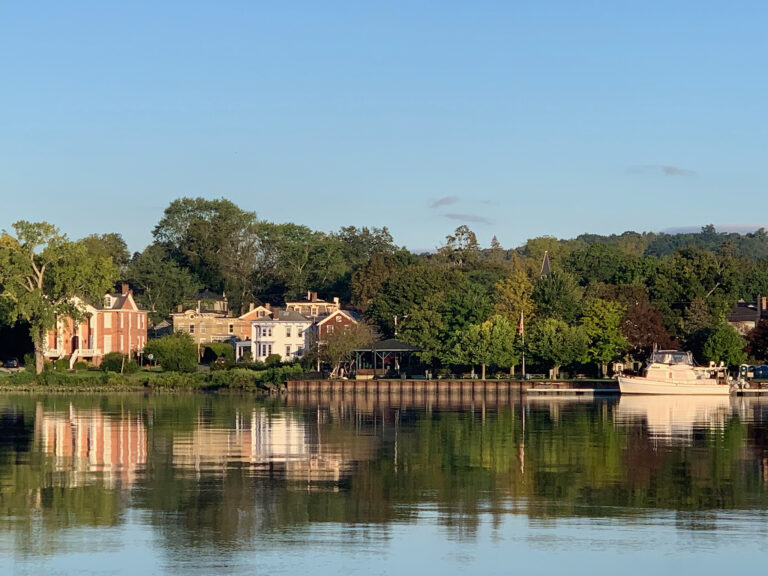
In an excerpt from his recently published memoir Fun Times in Boats, Blocks & Business, Harken Inc. co-founder Olaf Harken recalls the time his company helped try to break the world sailing speed record
My brother, Peter, and I have a common philosophy regarding future major investments: if we pay, we play. This has proved to be fun and a great excuse to limit the myriad of requests we receive from folks who’d like us to pay for their fun. We’ve sponsored several large-scale events over the years, and they all seemed to center around speed. We do not like to go slow. Our Vanguard high-performance dinghies were all designed to go as fast as we could make them and be legal. Our favorite, if not our most frustrating sport, is iceboating: a combination of race-car driving and sailing. In the summer, I have Stealth, a 38ft A-Scow, which has, by some standards of measurement, been referred to as the fastest standard production monohull sailboat in the world.
In addition, we’ve engaged in several high-profile projects centered on speed. We attempted but failed to break the world’s sailing speed record in a boat called Slingshot, and we developed and led a project to build Procyon, a 65ft cruising boat that was as fast as an all-out racer. I crossed the Atlantic Ocean in one of the fastest boats in the world, the giant 110ft catamaran Team Adventure. Each has its own story. Let’s look at the story of Slingshot.
Fast Time in the ‘70s
In 1980 my brother, Peter, and I, together with North Sails and the Gougeon Brothers (developers of the WEST System brand of epoxy resin), created a small syndicate to break the world speed record—which at the time was held by Crossbow at 31.8 knots. (In 2012 Paul Larsen set the current outright record at just over 68 knots.) We agreed to be part of this attempt and pay our share of the expenses, but only if we got to ride in the boat used for the event. One of the neat things about Slingshot was that she was designed to hold six people in the pod, which had been redesigned to be more like a seaplane hull that skipped on the water. So each company could put two people of their choice onboard.
The story of Slingshot goes back to the early days of 1978 when a man by the name of Carl Thomas conceived the idea while he was adrift in the Atlantic Ocean in a life raft. One of his other adventures had gone awry, so he took the time before being rescued to dream up Slingshot.
The idea was to build a 60ft-long proa with a large outrigger that extended outboard 44ft and had a pod out at the end of the outrigger. From there, the helmsman steered while the crew operated the sails and the outrigger, which could be cranked from one side to the other for leverage, forming a trimaran. The theory behind the rig was that it operated similarly to a windsurfer, where the mast would lean over as far as 30 degrees and provide lift to the whole boat. This also allowed a larger sail to counterbalance the pressure of the wind on the sail. The challenge, however, was to keep the rig from falling over: when the outrigger was fully extended, there was no leeward shroud to keep the rig from falling. It was completely up to wind pressure to hold it, and the outrigger needed to be re-centered before slowing down to stop the boat.
Carl commissioned Gougeon Brothers to build the boat in 1978, and he took it over to Weymouth, England, where the world speed trials were normally held. The wind, however, did not cooperate, and Carl was not able to achieve the record. He made another attempt the following year, but the boat had a breakdown that couldn’t be repaired before the trials ended.
After that, Terry Kohler, the owner of North Sails, talked with Peter and Jan Gougeon about refitting the boat and chartering it for another attempt at the world record. It took Peter a couple of seconds to think it over, and we were in the game. The Gougeons also enthusiastically agreed to give it a try.
We had a lot of preparation to do. The first item on our list was to find a suitable location with flat water and high winds. We also needed to find an official to measure her speed runs and witness any attempt. I asked Bob Shields, the head measurer of the United States Yacht Racing Union if he would accept the job; I knew he’d be fair and thorough. Bob agreed, and we chose a spot behind the breakwater at Galveston, Texas, in March and April when the winds were strong. There was a North Sails loft there and all the help we needed. The winds were also pretty steady and in the right direction. Slingshot was designed to operate at her best in 20 to 25 knots; Crossbow, by contrast, needed as much as 30 to 40 knots to compete.
The people of Galveston had really gotten to know about the event that was happening off their shores. Their hospitality was incredible, and many spectators came to watch. With our bright red Slingshot T-shirts identifying us, we were constantly being treated like celebrities. This made the whole event a lot more fun and something we will never forget.
Representing North Sails was Ron Sherry, a really hot iceboat sailor, and John Maudlin, who’d built his own boat to try for the world speed record. Dan Reichelsdorfer of North managed the logistics and support boat, and Jan Gougeon was our driver. (In addition to creating the WEST system, he was an international DN iceboat champion.)
Slingshot had hydraulic steering and a hose that ran to the end of the rack so the helmsman could steer from the windward side. Also on the Gougeon team was Mike Zutech, nicknamed Z-Square, since he looked at every problem mathematically. Mike, a NASA physicist, invented a system we called the Zutalator: he connected lines to each one of the battens so that he could adjust the camber of the sails and keep lots of wind pressure on the sail when the boat was slowing down. The rig needed all the assistance it could get to keep the mast up.
Peter’s job was to handle the jib, which he did from the front of the pod. My job was to winch the rack in or out from the main hull. After I’d extended it to its full 44ft, I’d run up the crossbeam and jump into my seat. At one point in our speed trials, we did record a speed of 38 knots.
The beauty of Slingshot was her reliability. Many other boats built specially for record-breaking had inherent problems that kept them in the repair shop most of the time. By contrast, we frequently made as many as 10 runs a day with no breakdowns. However, we did have a few—the most exciting of which was when Jan lost his steering.
No Steering!
We were in about 18 knots of wind going at a speed of a little over 27 knots when we heard a muffled noise from the back of the boat. Through all the wind noise, this sound was a little hard to distinguish. But it got a little louder as the situation developed; before long, we heard Jan say, “I haven’t got any steering.”
The boat peeled off and accelerated to a speed that probably equaled the world speed record. As the boat kept flying downwind, all eyes looked up: with the rack all the way out, the mast was going to come down. Peter, sitting in the front of the pod, figured it was coming down right on top of him, so he bailed out of the boat at around 30 knots and skipped across the water like a flat stone. I don’t think he realized what it’d be like to hit the water at that speed.

Sure enough, the mast did come down—but slowly, and fortunately with very little damage. Still, the rudder needed repair, which took some time. The boat was out of commission for several days, and the delays caused by the rudder and poor wind conditions decreased the chance of winds being strong enough to break the record.
In the meantime, Peter and I traveled back and forth between Milwaukee and Houston to keep up with our day jobs at the Harken headquarters in nearby Pewaukee, Wisconsin. The rudder had been fixed, but while we were away, a small crew took Slingshot out for sea trials in very light air. She was under tow by the North support boat when all of a sudden the wind came up to over 50 knots and the waves picked up to 5ft.
The boat was getting slammed around until the tow line finally broke. Slingshot took off with only two people on board, shooting downwind and aiming right at the breakwater. The crew tried to steer with the mast, but she smashed into the breakwater at full speed, and the hull broke into pieces in no time at all. The two crewmembers were able to scramble up the crossbeam and get off the boat before it was completely destroyed.
And that was the end of Slingshot—an expensive effort, but really a lot of fun. A major disappointment was that we felt that the boat really did have the potential to break the record because of her reliability and the great design of having the sail lift the hull to decrease the drag.
MHS Fall 2016











